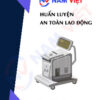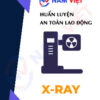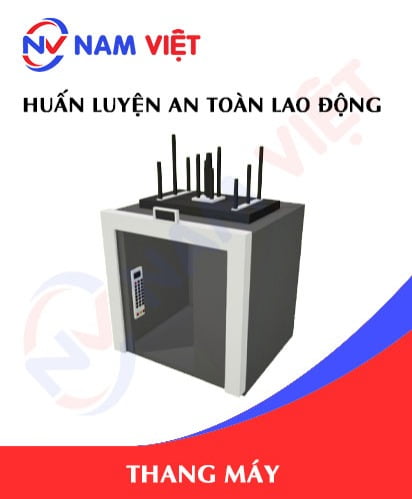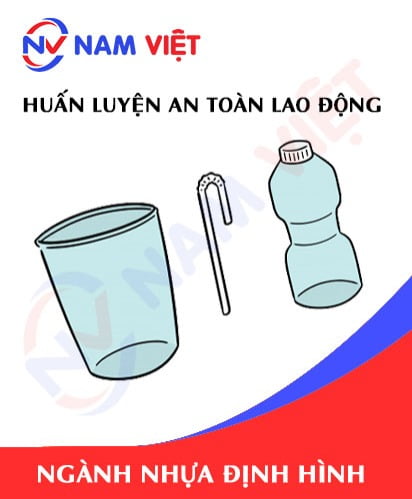Occupational Safety Training for Operating Medical Autoclaves
99,000 ₫
Note: The above price is calculated per person and may vary depending on the number of trainees participating in the course and market fluctuations. For more accurate pricing support, please refer to the pricing list or contact our consulting staff directly.
Occupational safety is an important issue when operating the medical autoclave and needs to be addressed promptly to ensure the health and safety of workers and enhance the reputation of businesses here. The Occupational Safety Training is one of the effective solutions to raise awareness on how to prevent occupational accidents for workers operating the medical autoclave.
Table of Contents
Toggle1. Overview of Medical Autoclave
a. What is a Medical Autoclave?
A medical autoclave, also known as a healthcare autoclave, is an essential device in the medical field used to eliminate bacteria, viruses, fungi, and other microorganisms through the application of high-pressure steam and high temperature. This process is called sterilization or disinfection.
The working principle of a medical autoclave is based on the combination of pressure and high temperature. When medical instruments are placed inside a tightly sealed autoclave, steam is generated, creating high pressure. The temperature inside the autoclave is then raised to a level sufficient to completely destroy harmful microorganisms. The required time and temperature may vary depending on the type of material and microorganisms to be sterilized.
Medical autoclaves are widely used in healthcare facilities, including hospitals, clinics, laboratories, and other healthcare settings. They play a crucial role in ensuring the safety and hygiene of medical instruments and equipment, preventing the spread of infectious diseases, and maintaining the quality of medical procedures.

b. Working Principle of a Medical Autoclave
The working principle of a medical autoclave relies on using high-pressure steam and high temperature to completely eliminate bacteria, viruses, fungi, and other harmful microorganisms on medical instruments. The specific operation process is as follows:
- Preparation: Before starting the sterilization process, medical instruments must be neatly arranged inside the autoclave. Ensure no liquids remain on the instruments, as this can affect sterilization efficiency.
- Generating Pressure: Water is added to the autoclave and heated to produce steam. The force from the steam creates internal pressure. This high pressure is essential for sterilization as it raises the sterilization temperature and ensures the steam penetrates every corner of the instruments.
- Raising Temperature: High pressure is combined with increased temperature inside the autoclave. The temperature is typically maintained between 121 and 134 degrees Celsius, depending on the structure and nature of the instruments. This high temperature destroys the cellular structure of microorganisms, resulting in their complete elimination.
- Sterilization Time: Once the desired temperature and pressure are reached, sterilization occurs for a set period, usually between 15 and 30 minutes, depending on the type of instruments and specific sterilization requirements.
- Cooling and Pressure Release: After sterilization, the autoclave cools down and releases pressure. This ensures safety when opening the lid and removing instruments without risk of burns or injury.

c. Industries Using Medical Autoclaves
Medical autoclaves are primarily used in healthcare and related sectors. Key industries include:
- Hospitals and Healthcare Facilities: Hospitals, clinics, surgical rooms, and other healthcare facilities use autoclaves to sterilize medical instruments such as surgical tools, dental instruments, X-ray devices, gauze, and other medical supplies before patient use.
- Medical Laboratories and Research Centers: Medical laboratories and research facilities use autoclaves to sterilize instruments, medical devices, samples, solutions, and other materials during research and product development.
- Pharmaceutical Industry: During drug production and packaging, autoclaves sterilize tools and materials involved in manufacturing, including containers, bottles, test tubes, and other equipment.
- Veterinary Medicine: In veterinary care, autoclaves sterilize veterinary instruments and are used in research and development of medical products for animals.
- Community Healthcare Centers: Community health centers, private clinics, and public health organizations also use autoclaves to sterilize medical instruments and ensure hygiene for daily healthcare operations.

2. Overview of Occupational Safety Training for Operating a Medical Autoclave
a. What is Occupational Safety Training?
- Occupational safety training for operating a medical autoclave involves sessions that provide workers with awareness on how to prevent workplace accidents. Workers directly handling medical autoclaves fall under Group 3.
- This training helps workers identify and prevent hazards, reducing the risk of workplace accidents while operating medical autoclaves.
REGISTER FOR OCCUPATIONAL SAFETY TRAINING SERVICE
b. Training Duration
Initial safety training duration:
- Total training time must be at least 24 hours, including assessment time.
- 8 hours of theory on safety policies and occupational hygiene laws
- 8 hours of theory on basic occupational safety and hygiene knowledge
- 4 hours of theory on specialized training content
- 2 hours of practical training on specialized content
- 2 hours for final theoretical exam
Training centers may divide this into multiple sessions depending on workers’ schedules, typically 6 sessions over 3 days if continuous training is arranged.
Periodic safety training duration:
- Before the occupational safety card expires, workers must undergo periodic safety training if they want to renew it, with a duration of at least 50% of the initial training time.
Explanation: Total periodic safety training time must be at least 12 hours, including assessment time. After successful completion, workers receive renewed occupational safety cards.
c. Training Content
| No. | TRAINING CONTENT | TRAINING TIME (HOURS) | |||
| Total | Including | ||||
| Theory | Practice | Assessment | |||
| I | Safety policies and occupational hygiene laws | 8 | 8 | 0 | 0 |
| 1 | Overview of occupational safety and hygiene legal documents. | 6 | 6 | ||
| 2 | Standards and technical regulations on occupational safety and hygiene. | 1 | 1 | ||
| 3 | Specific regulations from state management agencies on occupational safety and hygiene when building, expanding, or renovating facilities for production, use, storage, and inspection of machinery, equipment, materials with strict safety requirements. | 1 | 1 | ||
| II | Basic occupational safety and hygiene knowledge | 8 | 8 | 0 | 0 |
| 1 | Basic knowledge of hazards and harmful factors at the workplace. | 4 | 4 | ||
| 2 | Methods for improving working conditions. | 1 | 1 | ||
| 3 | Safety culture in production and business. | 1 | 1 | ||
| 4 | Rights and responsibilities of employers and employees; safety policies for workers; functions and duties of safety networks. | 1 | 1 | ||
| 5 | Occupational safety rules, signage, use of safety equipment and personal protective gear; first aid skills and occupational disease prevention. | 1 | 1 | ||
| III | Specialized training content | 6 | 4 | 2 | 0 |
| Comprehensive knowledge of machinery, equipment, hazardous substances; risk analysis and management; safe working procedures with machines, equipment, and materials with strict safety requirements. | 6 | 4 | 2 | ||
| IV | Final safety training assessment | 2 | 2 | 0 | 0 |
| Total | 24 | 22 | 2 | ||
See more training content for all 6 groups
d. Occupational Safety Card
After completing the occupational safety training and passing the exam, workers are issued a Group 3 Occupational Safety Card (commonly referred to as Occupational Safety Certificate for Group 3).
The Group 3 card displays information such as full name, date of birth, job, work environment, training duration, red seal, and signature confirming completion of the training.
According to regulations in Clause 2 of Article 24, Decree 44/2016/ND-CP, there are two cases:
- If the worker has an employment contract with the employer, the employer must sign and stamp the card after the worker completes Group 3 training and passes the exam.
- If the worker is freelance or temporary without a contract, the training provider must sign and stamp the card after the worker completes the training and passes the exam.

3. Hazards for Workers Operating a Medical Autoclave
Operating a medical autoclave can pose certain hazards to workers if safety measures and proper procedures are not followed. Below are some common hazards:
- Risk of burns: Medical autoclaves operate at high temperatures and pressures to sterilize medical instruments. Improper handling when opening the lid or handling items after sterilization can result in burns from direct contact with hot steam or high-temperature items.
- Risk of infection: During operation, bacteria and viruses may spread if sterilization procedures are not properly followed. This can lead to the risk of infection for workers and nearby personnel.
- Electrical safety risks: Medical autoclaves typically use electricity to generate heat and pressure. Electrical malfunctions or device failures can cause electric shock or equipment damage.
- Chemical hazards: Some autoclaves may use sterilizing chemicals in addition to steam to achieve higher sterilization effectiveness. Direct contact with these chemicals can be harmful if safety procedures are not followed.
- Occupational accident risks: Operating a medical autoclave may involve moving heavy items, handling hot surfaces, and other activities that could lead to workplace accidents if safety protocols are ignored.
To minimize these risks, workers should be trained in safe autoclave operation and must comply with all workplace safety regulations and procedures. Wearing appropriate protective clothing, goggles, and following hygiene and safety procedures is particularly important.
4. Occupational Accident Control Measures for Operating a Medical Autoclave
To control occupational accidents when operating a medical autoclave, the following specific safety measures should be implemented:
- Training and guidance: All staff must be trained in autoclave operation and related safety measures. Ensure they understand how to use the autoclave, sterilization procedures, and accident prevention measures.
- Use of personal protective equipment (PPE): All personnel must be provided with and required to wear PPE such as insulating gloves, safety goggles, protective clothing, and sturdy shoes to protect against burns and injuries.
- Periodic equipment inspection: Autoclaves should be regularly inspected to ensure they operate safely. Checks include pressure, temperature, and mechanical components of the device.
- Compliance with safety procedures: Workers must follow safety procedures outlined by the workplace, including opening lids and handling sterilized items, handling chemicals if used, and personal hygiene regulations.
- Use support systems and stands: When moving or repositioning the autoclave or its contents, use support systems and stands to reduce the risk of accidents involving heavy items.
- Monitoring and feedback: Supervisors should regularly monitor work processes and provide immediate feedback for any hazardous situations or safety violations. Hazards should be reported and addressed promptly.
- Periodic inspection of medical autoclaves to detect safety issues such as wear, mechanical faults, or failures early, thereby reducing the risk of workplace accidents.

5. Benefits of Occupational Safety Training
An Toàn Nam Việt provides businesses with the following benefits after completing occupational safety training courses in accordance with Decree 44/2016/ND-CP on Occupational Safety and Health:
- Workers can identify potential occupational hazards and take preventive measures to avoid accidents.
- Businesses can establish risk prevention measures in production, operation, and maintenance processes.
- Minimizes costs associated with workplace safety incidents.
- Uninterrupted production improves labor productivity and product quality.
- Compliance with labor safety laws avoids legal risks.
- Enhances credibility and professionalism, boosting the company’s brand image.
Nam Việt’s training courses serve as a preventive solution against external hazards, helping individuals avoid injuries or even fatalities.
REGISTER FOR OCCUPATIONAL SAFETY TRAINING
6. Customer Feedback After Completing Training
An Toàn Nam Việt has years of experience partnering with businesses across Vietnam, particularly in the southern provinces. This responsibility is highly valued, which is why our Occupational Safety Training programs are increasingly professional. The company’s growth is driven by both positive feedback and constructive suggestions from business partners. Below are testimonials from some clients we have served.
7. An Toàn Nam Việt’s Occupational Safety Training Capacity
An Toàn Nam Việt is a reputable and high-quality occupational safety training center in Vietnam. Training sessions are conducted continuously at production workshops, factories, and construction sites across all 63 provinces.
REGISTER FOR OCCUPATIONAL SAFETY TRAINING
Occupational Safety Training License
- An Toàn Nam Việt has been inspected and certified by the Department of Safety under the Ministry of Labor, Invalids and Social Affairs, confirming our qualifications for occupational safety and hygiene training. This further strengthens our capacity for occupational safety training.

Training Materials
- Before being used in occupational safety training courses, all materials are reviewed to ensure accuracy and practical effectiveness.
- Our instructors’ teaching methods follow An Toàn Nam Việt standards, developed by occupational safety experts to maximize knowledge retention.
Facilities
- Controlling classroom factors improves teaching performance and learning effectiveness.
- Our facilities feature spacious classrooms meeting standards for area, lighting, and training equipment.
8. Nationwide Reputable Occupational Safety Training Center
At An Toàn Nam Việt, occupational safety education is a top priority. We focus on equipping workers with knowledge to protect themselves, contributing to national development.
We carefully prepare all tools, equipment, curricula, materials, audio, and lighting to ensure effective training.
Our instructors are experienced experts, some with research on hazard identification and prevention across industries.
Lectures are practical and engaging, helping workers absorb knowledge comfortably. Training strictly follows Decree 44/2016/ND-CP, teaching measures to prevent hazards and self-protection, applicable in real work situations.
Our training center is proud to offer professional, reliable occupational safety training with advantages:
- Competitive training fees with ensured quality.
- Flexible training schedules according to company production.
- Quick and compliant certification procedures.
- Experienced instructors.
- Classroom environment optimized for effective learning.
- Courses tailored to workplace safety requirements.
- Dedicated and professional service for accurate, fast support.

9. Additional Occupational Safety Training Materials
- Occupational Safety Training Materials Set
- Occupational Safety Materials for Operating a Medical Autoclave
- Occupational Safety Training Test Set
- Multiple Choice Test for Operating a Medical Autoclave
- Slides for Occupational Safety Training on Medical Autoclave Operation
1 review for Occupational Safety Training for Operating Medical Autoclaves
No comments yet















phanminhhang341
Good labor safety unit